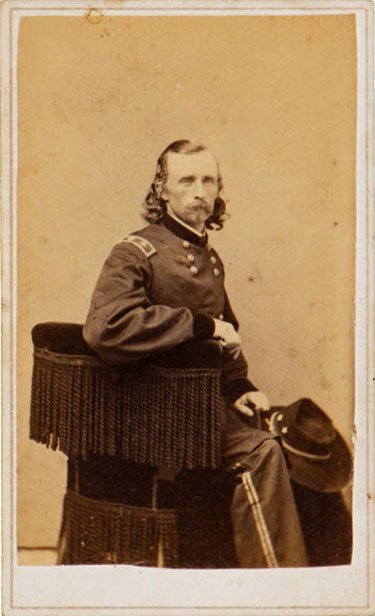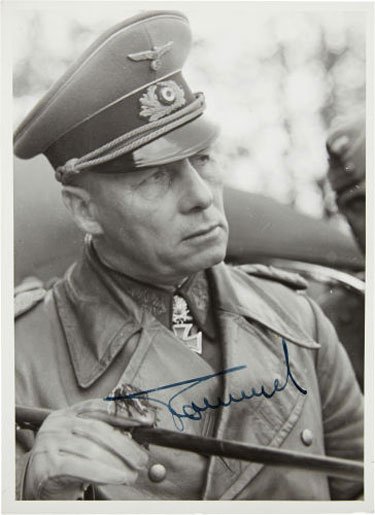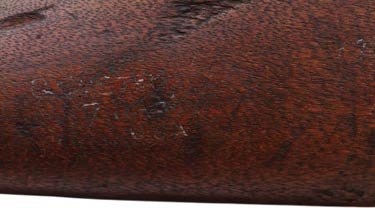Category Archive 'Heritage Auctions'
25 May 2018


George Armstrong Custer, Carte de Visite by Goldin. Taken in May 1865, just after the conclusion of the war. Custer was in Washington for the Grand Review celebration.
Tom Slater, in the latest Heritage email, introduces the upcoming June 9th GEORGE ARMSTRONG CUSTER AND THE PLAINS INDIAN WARS Auction at Heritage Auctions:
For Garryowen And Glory!
Those were the prophetic closing words of the regimental song of George Armstrong Custer’s 7th Cavalry. As a boy growing up in the days of black-and-white TV my favorite “old movie” was They Died with their Boots On, starring the incomparable swashbuckler Errol Flynn as G. A. C. I watched it countless times. Who could forget the catchy tune played over and over during the film, or the image of Custer, the last man standing, blazing away, six-gun in each hand, as he was ridden down by a horde of Indians? Eventually I would have to unlearn most of the contrived “history” related in the movie, but my disillusionment did little to discourage my fascination with the saga of Little Bighorn and Custer’s Last Stand.
Barely 200 men perished with Custer, a seemingly insignificant number when compared to the tens of thousands of casualties in other American battles. Why does the Little Bighorn saga still hold such fascination nearly a century and a half later? Undoubtedly, part of the allure lies in the fact that Custer was a genuine American hero long before the events of 1876. The youngest man to be made general during the Civil War, he was famous for his exploits as a cavalry commander — as well as for his golden locks and flamboyant dress. After finishing dead last in his West Point class, Custer certainly made his mark. During the decade before Little Bighorn he led the 7th Cavalry as they fought Indians and explored new territory with the Yellowstone and Black Hills Expeditions. By the time of the disastrous battle in 1876 he was a celebrity and a household name.
Further adding to the drama was the possibility that personality traits and conflicts played a role. Was Custer brash and irresponsible in rushing to attack the large Indian encampment, or was he simply acting on what he thought was reliable military intelligence? Was the failure of Capt. Frederick Benteen to come to Custer’s aid a sound military decision, or was he influenced by his well-known personal distaste for his commander? Was Major Reno’s retreat after initially assaulting the village an example of cowardice, or an unavoidable response in the face of unanticipated, overwhelming resistance?
Lastly, there was the epic significance of a number of Plains tribes and bands coming together for one last, great celebration of their vanishing way of life, and to make a final valiant stand against the inevitable encroachment of “civilization.” It is now known that the Indian camp was aware of the soldiers’ approach, but failed to scatter as had been their tactic in the past. Rather they waited almost passively for the great confrontation, knowing full well that, even if they managed to win the battle, they had already lost the war.
It is our great honor to bring to you on June 9th an amazing auction focused on those historic events and the personalities associated with them, titled “George Armstrong Custer and the Plains Indian Wars.” We are especially gratified to present the important artifacts and relics amassed by Glenwood J. Swanson, the highly respected Custer collector and scholar whose items make up a large portion of the auction. Glen is particularly appreciated for his ongoing support of archeological endeavors at the Custer Battlefield and for his landmark book, G. A. Custer His Life and Times, published in 2004. Lavishly illustrated, largely with items from his own collection, this book gives wonderful insights into Little Bighorn and the men who fought there.
22 Oct 2015


Heritage Auctions at their Historical Manuscripts Grand Format Auction #6149 in New York on November 4 – 5th, among many interesting items, will be offering several lots associated with WWII German Field Marshall Erwin Rommel:
Lot 49179: An never-sent autograph letter, written two weeks before Rommel’s death by forced suicide, dated October 1, 1944, to Hitler justifying reverses at Allied hands in Normandy and attempting to defend his Chief of Staff Lieutenant General Hans Speidel (arrested three weeks earlier for participation in the plot to kill Hitler).
Lot 49180: A typed letter to Captain Helmuth Lang,his aide-de-camp, dated September 18, 1944, thanking that officer for his letter and commenting on Rommel’s recovery from an Allied air attack two months earlier.
Lot 49181: Four Photograph Albums compiled by Hellmuth Lang containing 750 photographs, a presentation copy of Cornelius Ryan’s Book The Longest Day, and an original copy of Rommel’s Death Announcement.
Lot 49182: A signed photograph of Erwin Rommel (see above) formerly the property of his aide Helmuth Lang.
Heritage Auctions’ Thoughts on Rommel’s Last Days.
06 Dec 2012


George Armstrong Custer’s Personal Army-Issue Model 1865 Spencer Carbine
A good friend from Yale, Tom Slater (JE ’72), is Director of Americana at Heritage Auctions in Dallas. An email update from that auction house reports that Tom has outdone himself in putting together a really spectacular group of offerings for Heritage’s December 11th & 12th Western Americana auction
The undoubted highlight of the sale is George Armstrong Custer’s personal Spencer repeating carbine, bearing his name scratched on the buttstock, and frequently mentioned in his accounts of hunting. The bidding starts at $50,000; but, even with recession clouds still lowering over Obamistan, it will probably go much higher.
[T]he Spencer carbine offered here pre-dates his Fort Abraham Lincoln period, it does date from the Indian Wars, and could quite possibly have been with him at the Battle of Washita.
It was part of the legendary collection of Dr. Lawrence A. Frost of Monroe, Michigan, who at one time had what may have been the most extensive private collection of Custer artifacts and relics ever assembled. A signed identification tag in Frost’s hand which accompanies the gun identifies it as a “Spencer Carbine – Saddle Ring / Cal. 50, No. 3658, Model 1865 / ‘G. Custer – 7 Cav USA’ cut into wooden stock…Used by Gen. Custer in Kansas in 1867 campaign.” …
Dr. Frost purchased the carbine in 1955 from Howard Berry. A notarized bill of sale describes the gun in detail. In a 1973 letter (a copy of which is included in this lot), Frost refers to purchasing various Custer items from Berry, whom he describes as “a former 7th Cavalryman”. Frost states that he showed them to James Calhoun Custer (a nephew of Gen. Custer and son of Nevin Custer), and that Custer assured him he remembered these items which had been shown to him by his father who stated that they were the General’s.
Custer used a wide range of military and commercially available firearms over the course of his career, but he had a special familiarity with Spencer carbines. During the Civil War his Michigan regiments were armed with Spencers (Carbines of the U.S. Cavalry, John McAulay, p. 32). As the war ended, a new Spencer model was issued to the army with a more powerful 56-50 cartridge (Spencer Repeating Firearms, Roy Marcot, pp. 80-81). When the 7th Cavalry was formed in 1866 (Bugles, Banners and War Bonnets, Ernest Reedstrom, pp. 1-2), the Spencer Carbine became standard issue (Carbines of the U.S. Cavalry, p. 88), and was in use by them until replaced by the Sharps carbine in 1870 (Carbines of the U.S. Cavalry, p. 95). In his 1980 book, Nomad, George A. Custer in Turf, Field and Farm, Brian W. Dippie reproduces an 1867 article written by Custer in which he describes in great detail a buffalo hunting expedition. He describes learning that pistol shots “only seemed to increase (the buffalo’s) speed.” Accordingly, Custer wrote, “I concluded to discard the use of my revolvers and trust my Spencer carbine” (p.117). The example offered here, serial #3658, is the 1865 model and should not be confused with the Spencer rifle gifted to Custer in 1866; that gun has never surfaced (Spencer Repeating Firearms, p. 152). The presentation gun would have been the 56-44 sporting model.
Custer’s regard for his Spencer carbine is evidenced in his own words in his autobiography, My Life on the Plains, where he writes: “Leaping from my bed I grasped my trusty Spencer which was always at my side” (p. 77).

“G. Custer — 7 CAV, USA” cut into buttstock.
Your are browsing
the Archives of Never Yet Melted in the 'Heritage Auctions' Category.
/div>

Feeds
|







